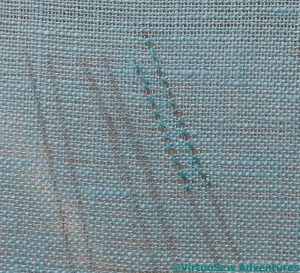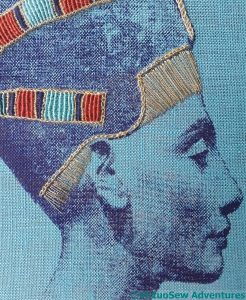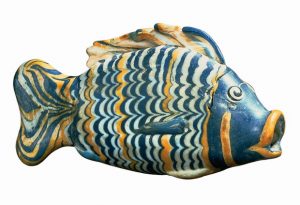Category: Large Embroidery Projects
Another Attempt at the Dig House
I’m continuing to experiment with my embellisher, trying to learn new tricks.
I’ve found a photo of the Dig House from a different view to the previous one I tried, and cut out some pieces of felt to represent the trees and the various pieces of building. It’s not going to be a very accurate representation, because, firstly, my cutting wasn’t as accurate as it could have been, and second, I’ve found that needlefelting doesn’t always go to plan.
That said, a bit of stitchery helps to keep the pieces at least approximately in place.
I felt the felt of the trees looked a bit too solid, and snipped holes in it, snipped the edges, and then tugged and tweaked at it to open up the fabric.
Then I started to use my embellisher. And oh joy, a needle broke! I changed the needle plate and slowed down a bit after that. It turns out that three layers of even this fairly light felt are a bit much for the machine.
However, after much slow and careful embellishing, I have this.
The trees look much better now, with the edges and the holes satisfactorily destroyed and battered around the edges. The various layers of felt are melting into one another and flattening together.
This should at least provide me with an interesting basis for further stitched details!
The Two Princesses – Drapery, stage 2
The idea of using the netting is that it does not become caught up in the embellished fabric, and that it prevents bits of embellishment from becoming caught up on the needlehead and generally misbehaving.
As you can see, that sometimes doesn’t work quite as well as one might wish! Fragments can, and do, work themselves through the holes torn in the netting by the embellisher’s needles, and then jump with alacrity onto the needles, where they whizz up and down before the bemused eyes of the person operating the machine, causing no little apprehension as they do it!
There’s something else that doesn’t quite go to plan, as well. The netting does indeed become somewhat enmeshed with the felt.
As you can see, my little additions are by no means felted into the backing piece, but I’m already having to be very careful to peel off the netting, and if I had done much more with the embellisher, I might never have got the netting off at all!
I think it would be fair to say that I don’t really have anything like a real understanding of the effect of the embellisher on particular materials or combinations of materials. I’ve several more projects in mind so I’m sure my understanding will grow, but even by my standards, this is a venture into the unknown.
You can see that some of the pieces moved, and some never attached themselves at all. The pattern is distinctly higgledy-piggledy, and the elements aren’t equally firmly attached.
That said, I’ve managed to create something that has the warm red and the flashes of blue and gold, and although it isn’t the same pattern as the one in the fresco, it is certainly reminiscent of it.
I’m going to try another method entirely for a second section of drapery, and see whether that creates the effect I want.
Finishing the Glass Nile Tilapia Fish
There was a pause after I got the dorsal fin done. His lips and gill markings, and the pectoral fin, are all worked in blanket stitches, nesting them to outline the shapes in some cases and putting the edge where I wanted the firmer line in others.
I don’t have a dark enough linen thread for the dark of his eye, so the chain stitch spiral is of linen (the white) but then the dark is the navy silk perle I used on Nefertiti’s headdress. It works pretty well, I think. It looks as though he’s rolling a beady eye to watch someone he has his suspicions of!
I decided not to do anything too complicated for his head – simple irregular brick stitch. I didn’t want to split the threads, but I did my best to create a smooth surface.
When it came to the dragged stripes on the body, there was another pause. I knew what I should probably use, but I had to persuade myself that there wasn’t anything better. The last time I used stacked fly stitches (the fourth panel of the Persian Fantasy, which I did about twenty years ago and blogged about when I started blogging in 2010) the wretched things nearly drove me up the wall!
I think the fly stitches were better than other choices – although one of these days I may take the combed pattern as the inspiration for some Bargello work. That said, I’m not sure I like my Fishie as much as I expected to. His tail fin took some wrestling with, and doesn’t have the “flow” I was aiming for. It’s very possible that in a few months he’ll be fished out (sorry!) and reworked somewhat.
Starting the drapery for the Two Princesses
I’m going to build up the panel in layers, so I began by playing with bits of felt. I’ve cut small squares and triangles from other pieces of felt I have to hand, and begun to make some attempts to build up patterns with them.
The darker red shown here is actually one of the pre-felts painstaking split horizontally and then cut into bits. The idea was to produce something that gave the impression of folds in the drapery. I’ve come to the conclusion that that doesn’t work, and what’s more, I don’t think it ever will, partly because needlefelt applique turns out not to be a terribly exact science..
This seemed better. You’ll notice that it’s a bit haphazard, and that it runs over the whole piece, even though we know I will be covering quite a bit of it with the princesses themselves. I learnt a long time ago (with the Camberwell Panel, in fact) that when layering like this it is a false economy of time and effort to attempt to minimise the details on intermediate layers. This way I have more freedom for the exact placement, and can move the pieces around until I am happy with them.
Once I had layouts I was happy with, for both the drapery at the back and the patterned bench or divan covering the girls are sitting on, I created sandwiches of netting with my layouts- lightly hand-needlefelted – in the middle, and two layers of net back and front.
Time to get my embellisher out of its box!
The Head of Nefertiti – further details
I suddenly realised that I haven’t got any representations of the Aten in the panels. Considering that Akhenaten’s new, monotheistic devotion to the Aten actually created Amarna (Aketaten in his day), that is more than a little remiss of me. So the extra details I am planning for Nefertiti – shown here, drafted on tracing paper laid over the the print I didn’t use for stitching – begin to right that wrong.
I’ve drawn the rays of the Aten ending in little hands outstretched in blessing, as seen in many wall-carvings and paintings at Amarna. For some reason (research to be done…!) the hands nearest the noses of Nefertiti and Akhenaten often hold an ankh, so that is also included.
I’ve added in Nefertiti’s cartouche, although I think I may have drawn it too large for the design as a whole, and my own, which will include my initials in Morse Code, as this is a standalone companion piece.
I want the lines to be there, and yet not there, so I found some filament silk that I bought at Texere Yarns before they closed their store, and had a go with it, using reverse herringbone stitch, as I did for the contours of The Map of Amarna.
And it completely disappeared.
Oh dear!
So this is the next version, reverse chain stitch using a 2-into-1 twist. I’m much happier with that, although twisting the thread before I stitch with it does rather slow down the stitching part of it!
But still, here I am, stitching with hand-twisted thread, twisted by me. Never would fifteen-year-old me have believed I would be doing that!
If my Grandmama could see me now….
Two princesses
There’s a fresco of two of the daughters of Akhenaten and Nefertiti, which is quite well known, and indeed, was mentioned to me by the speaker, when I went to a lecture at the Egypt Exploration Society about the textiles in Tutankhamun’s tomb. I decided to have a go at representing this fragment using my embelllisher, to provide a companion piece for the three Amarna Geese I worked a while back.
Children in ancient Egypt – of whatever rank – appear to have run around naked much of the time, and with shaven heads. I’ll just have to get the outlines right….
I bought some more of the pre-felts I used for the Amarna Geese at “Sewing For Pleasure” in Birmingham, on the day I met up with Sue of Tortoiseloft blog.
Then I printed out the image I found online as large as I could and started planning my variation. It won’t, of course, be an exact reproduction of the fresco. It will be a sort of inlaid felt version of what I think might have been the real life inspiration for the scene.
Long-time readers may recall that I discovered with the Amarna Geese that embroidered details help to bring a scene to life, and at least if the embroidery is worked in wool, responds well to being needlefelted.
So after cutting out my two little princesses, in a single piece, I started to add details – lines to make sense of the bodies, the delicate eyes and eyebrows, the lips, and the necklaces. I’m very pleased with how they’ve turned out, because the felt doesn’t take pencil, so I was on my own – drawing with my needle.
Now I have to work out how to create the impression of the fabric backdrop and bench my two little princesses are sitting on….
The Head of Nefertiti – continuing progress
So this is where we left the Head of Nefertiti. the polychrome bands and the gold edges of the headdress are done, and I have worked a section of necklace.
I keep flip-flopping between feeling that that section of necklace is just right, and feeling that it really isn’t enough at all. I like the sense of a delicate flash of colour barely surviving the years, but at the same time, there’s an inner glitter-girl that wants to see a bit more than that..
So, while I think a little more about the necklace question, I thought I’d make another attempt at the browband. This time it is simply straight stitches, in a slightly finer thread than the rest of the gold stitching. It’s not perfectly regular, but, again, the slight unevenness evokes the damage of the years.
And besides, by now, you must know that regularity of stitching is not my forte!
So, again, I find myself at a pause.
I’m happy with the browband, I think, definitely happy with the polychrome bands, and the gold trim.
However, I’m still not sure whether I’m happy with the necklace.
Since my thought is to quilt a pattern into the background, I had best be certain that I’m happy before I start attaching padding and picking patterns!
More progress on The Head of Nefertiti
Once I had finished the polychrome bands, I sat back and looked at them. Using the darker shades of the colours in the darker part of the print helps to tie it all together and wrap the bands around the headdress.
I had a moment or two of concern, then decided that I would not, after all, ruin everything if I continued to add the other elements of the design that I had planned. There is always a moment or two of fear, especially when an early section has gone well!
The original bust shows something that looks like a browband of gold, fairly plain and flat. I fished out a piece of gold kid, but although the photograph doesn’t show it very well, the kid is the wrong colour (too pale, and not yellow enough) for the gold thread, so I have to think of something else.
*Thinks hard*.
Meanwhile, I thought I would experiment with the necklace, or collar. My thought was that, rather than do the whole thing, I would do a small section of it, to make sure that I maintain the feeling of an embroidery, and not a portrait of a portrait.
What I have done here is to make radiating stitches of the gold thread, and then use the same whipped filling stitch I used on the polychrome bands, but alternating them so there is a hint of a gold net underlying the collar.
I like this, but maybe I do need to do an entire collar’s worth.
*Thinks hard*. Again.
Nile Tilapia Fish
There is a glass vessel which frequently shows up in image searches relating to Amarna, a representation of a Nile tilapia fish. I saw it reconstructed by a modern glassworker in a recent programme about the art of Ancient Egypt presented by the British art critic Alistair Sooke. The glassworker said it was a somewhat unnerving technique to do, and with all his experience, and all his practice, he was never entirely confident of his results until a fish was finished,
That being the case, it seemed to me that as an example of the skill of the artisans of Amarna, the glass fish deserved to be included. I’ve found a public domain image to act as my source – and to show you what I’m talking about. I’m thinking of padding it slightly and attaching it to one of the background panels as a fish-shaped slip, rather than a rectangular patch, but we will have to wait and see what seems the right thing to do when I’ve finished.
I’m using some rather lovely vintage linen thread, bought at the recent “Sewing For Pleasure”, on a fine but sturdy cotton. I wanted something that would not require a backing, but I’m not sure that the fabric will be left to show, so I could have used some plain calico. The thread is wonderful to work with, strong, lustrous, and resilient. Much better than any linen thread I’ve ever worked with before – they’ve tended to be stiff, and a little “dead” in feel. This stuff is a delight!
So far, the stitches are blanket stitch, seed stitches, chain, stem, and feather stitch. I’m rather enjoying this!
The Head of Nefertiti – working with Silk
You will recall that I was rather underwhelmed by the effect of my first attempt at weaving the silk into the gold. Leaving the threads loosely packed to allow the gold to show through allows them to look untidy, and the colour is somehow a little flattened, not the rich, strong colour I wanted.
So I decided to work the whipped style of filling stitch instead. It creates a strong colour, something like a grosgrain ribbon, in fact.
I’m using primarily colours from the Mulberry Silks “Nefertiti” colour range (appropriate, don’t you think!), and I’m happy with the rusty red. The navy is actually a heavy perle type and I’m not sure where it came from. That works too.
The lightest colour, however, on the far right, is too fine. It produces too retiring an effect, and weakens the whole effect. So I tried one of the stranded silks from Thistle Threads (lower example, left), and wasn’t convinced by that, either.
This looks better. In fact the two light blue-greens are different, although that isn’t as clear in this photo as I might have liked. They aren’t as green as I would have liked, but I’m reasonably happy. If I decide to redo them, I may have to redo the whole thing, as the unpicking earlier on has left the Ladder Stitch a bit floppy.




























